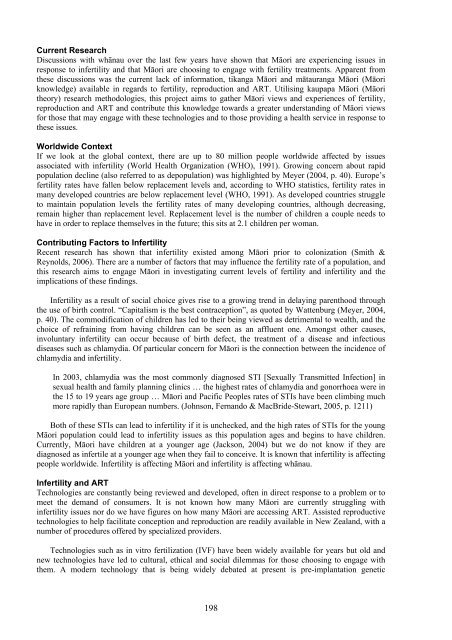traditional knowledge conference 2008 te tatau pounamu
traditional knowledge conference 2008 te tatau pounamu
traditional knowledge conference 2008 te tatau pounamu
Create successful ePaper yourself
Turn your PDF publications into a flip-book with our unique Google optimized e-Paper software.
Current ResearchDiscussions with whānau over the last few years have shown that Māori are experiencing issues inresponse to infertility and that Māori are choosing to engage with fertility treatments. Apparent fromthese discussions was the current lack of information, tikanga Māori and mātauranga Māori (Māori<strong>knowledge</strong>) available in regards to fertility, reproduction and ART. Utilising kaupapa Māori (Māoritheory) research methodologies, this project aims to gather Māori views and experiences of fertility,reproduction and ART and contribu<strong>te</strong> this <strong>knowledge</strong> towards a grea<strong>te</strong>r understanding of Māori viewsfor those that may engage with these <strong>te</strong>chnologies and to those providing a health service in response tothese issues.Worldwide Con<strong>te</strong>xtIf we look at the global con<strong>te</strong>xt, there are up to 80 million people worldwide affec<strong>te</strong>d by issuesassocia<strong>te</strong>d with infertility (World Health Organization (WHO), 1991). Growing concern about rapidpopulation decline (also referred to as depopulation) was highligh<strong>te</strong>d by Meyer (2004, p. 40). Europe’sfertility ra<strong>te</strong>s have fallen below replacement levels and, according to WHO statistics, fertility ra<strong>te</strong>s inmany developed countries are below replacement level (WHO, 1991). As developed countries struggleto maintain population levels the fertility ra<strong>te</strong>s of many developing countries, although decreasing,remain higher than replacement level. Replacement level is the number of children a couple needs tohave in order to replace themselves in the future; this sits at 2.1 children per woman.Contributing Factors to InfertilityRecent research has shown that infertility exis<strong>te</strong>d among Māori prior to colonization (Smith &Reynolds, 2006). There are a number of factors that may influence the fertility ra<strong>te</strong> of a population, andthis research aims to engage Māori in investigating current levels of fertility and infertility and theimplications of these findings.Infertility as a result of social choice gives rise to a growing trend in delaying parenthood throughthe use of birth control. “Capitalism is the best contraception”, as quo<strong>te</strong>d by Wat<strong>te</strong>nburg (Meyer, 2004,p. 40). The commodification of children has led to their being viewed as detrimental to wealth, and thechoice of refraining from having children can be seen as an affluent one. Amongst other causes,involuntary infertility can occur because of birth defect, the treatment of a disease and infectiousdiseases such as chlamydia. Of particular concern for Māori is the connection between the incidence ofchlamydia and infertility.In 2003, chlamydia was the most commonly diagnosed STI [Sexually Transmit<strong>te</strong>d Infection] insexual health and family planning clinics … the highest ra<strong>te</strong>s of chlamydia and gonorrhoea were inthe 15 to 19 years age group … Māori and Pacific Peoples ra<strong>te</strong>s of STIs have been climbing muchmore rapidly than European numbers. (Johnson, Fernando & MacBride-S<strong>te</strong>wart, 2005, p. 1211)Both of these STIs can lead to infertility if it is unchecked, and the high ra<strong>te</strong>s of STIs for the youngMāori population could lead to infertility issues as this population ages and begins to have children.Currently, Māori have children at a younger age (Jackson, 2004) but we do not know if they arediagnosed as infertile at a younger age when they fail to conceive. It is known that infertility is affectingpeople worldwide. Infertility is affecting Māori and infertility is affecting whānau.Infertility and ARTTechnologies are constantly being reviewed and developed, of<strong>te</strong>n in direct response to a problem or tomeet the demand of consumers. It is not known how many Māori are currently struggling withinfertility issues nor do we have figures on how many Māori are accessing ART. Assis<strong>te</strong>d reproductive<strong>te</strong>chnologies to help facilita<strong>te</strong> conception and reproduction are readily available in New Zealand, with anumber of procedures offered by specialized providers.Technologies such as in vitro fertilization (IVF) have been widely available for years but old andnew <strong>te</strong>chnologies have led to cultural, ethical and social dilemmas for those choosing to engage withthem. A modern <strong>te</strong>chnology that is being widely deba<strong>te</strong>d at present is pre-implantation genetic198
















